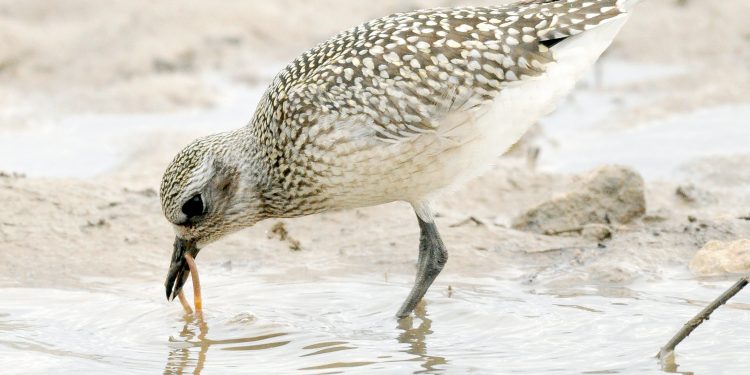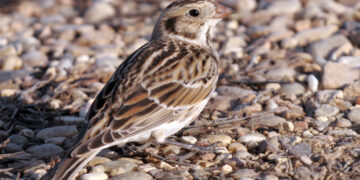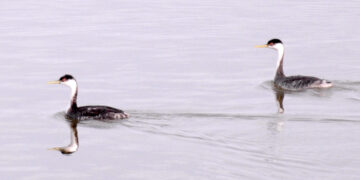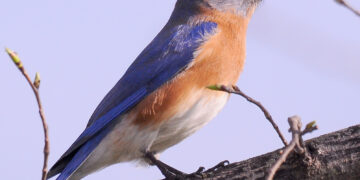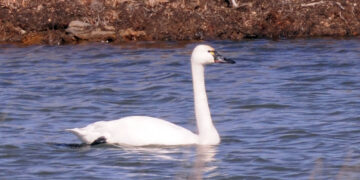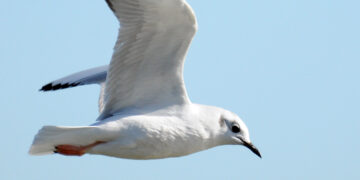The black-bellied plover passes through Oklahoma during fall and spring migration, the former of which is already underway.
It is a shorebird, similar in shape to a “shorebird” that is a permanent resident in southwest Oklahoma called a killdeer. You’ve most likely seen killdeer in shortgrass fields and area parking lots. The killdeer is also a plover.
The black-bellied plover is larger than the killdeer, and measures 11 to 11.5 inches in length. In fact, the black-bellied plover is the largest plover in North America. It also has large, dark eyes.
On many occasions, I’ve observed black-bellied plovers hunting on the shores of the Texas Gulf Coast. However, I’ve also had the privilege of watching them feed “inland” at area lakes.
At one lake, due to a massive amount of rain in the days prior, it was swollen beyond its banks. There really wasn’t a “shore” to be found.
However, there were a few temporary ponds left behind in nearby plowed fields.
A few black-bellied plovers — and many semipalmated plovers — were near these ponds where they were pulling worms from the mud left and right.
Obviously, it wasn’t this year as it’s been quite dry. It was during the month of September, however. Many species of shorebird have been spotted recently passing through the state.
The black-bellied plovers would pull the worms from the ground, then walk over to the ponds and “wash” the mud off the worms before consuming them.
The semipalmated plovers, however, did not.
It was, therefore, my conclusion that black-bellied plovers are more sanitary than semipalmated plovers!
Appearance
When the black-bellied plover passes through Oklahoma in the fall, it is a mottled grayish brown on its back and the top of its head. The belly is a mixture of light beige and white. Adults will have an underside that is much lighter than juveniles.
When breeding, the male has a solid black belly, chest and face. His back is mottled black, white and brown. It is quite striking in appearance. The breeding female is similar but has a black belly only.
When these birds pass through Oklahoma in the spring, their winter plumage is merging with the summer plumage, so their bellies often have black splotches.
The black-bellied plover is very similar in appearance to the American golden plover, and it can be difficult to tell one from the other.
The AGP is a little smaller than the BBP and has a slightly smaller, thinner bill.
One important thing to note: Whereas the black-bellied plover migrates through Oklahoma in spring and fall, the American golden plover only migrates through this area during the spring. In the fall, it flies offshore from the East Coast of North America nonstop to South America. When returning to its nesting grounds in the spring, it passes primarily through the middle of North America, including Oklahoma.
The American golden plover really is an amazing bird, but I will elaborate on that in a future article.
Range
Black-bellied plovers in North America nest in the Arctic on the dry tundra — in northern Alaska and northern portions of Canada. They winter all along the coasts of the United States, Mexico and most of coastal South America.
Diet
The black-bellied plover eats insects on its breeding grounds and during migration. During winter, it feeds on crustaceans, mollusks and marine worms.
Habitat
During migration, black-bellied plovers will visit lakes, ponds and flooded pastures and agricultural land.
Nesting
The female lays one to five eggs, usually three or four. According to the Cornell Lab of Ornithology, the young are born covered in down and are able to walk soon after hatching. They can feed themselves within one day.
The National Audubon Society reports that the parents will tend to the young for up to two weeks, then the young are on their own.
After migrating south in the fall, many juvenile black-bellied plovers are not ready to breed by spring, so they do not return to breeding grounds in summer and may remain through the season on more southerly coasts.
Odds and ends
• While watching these birds at the coast, I’ve often seen them standing on one leg and hopping around on one leg — the other leg tucked up in their belly feathers. They’re certainly not the only birds that do this. It appears as if they have suffered an injury, but if you approach them in an attempt to help, they will drop the second leg and either run away or fly away. I learned this as a young birder.
The reason birds do this, I later read, is to conserve heat. Kind of like when it’s cold out and we put our hands in our coat pockets.
• In the United Kingdom and other parts of Europe, the black-bellied plover is known as the grey plover.
Editor’s Note: Randy Mitchell is a freelance writer and photographer. He has been an avid birdwatcher, nature enthusiast and photographer for more than 40 years. Reach him at rnw@usa.com.
Want to reach a local audience and grow your business?
Our website is the perfect platform to connect with engaged readers in your local area.
Whether you're looking for banner ads, sponsored content, or custom promotions, we can tailor a package to meet your needs.
Contact us today to learn more about advertising opportunities!
CONTACT US NOW